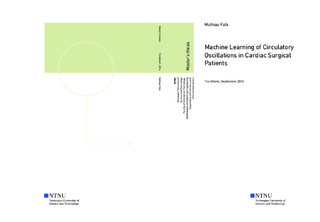| dc.description.abstract | The human circulatory system is a complex organ system, with multiple feedback and feedforward mechanism for regulation. When global circulatory variables are assessed, these exhibit distinct oscillatory patterns with several frequency bands with different amplitudes, probably because of the underlying complex regulation. Loss of complexity, or decomplexification, has been reported in several cardiac diseases, as well as after heart surgery. Electrocardiogram (ECG), arterial blood pressure (ABP) and laser Doppler flowmetry (LDF) of peripheral blood flow has been recorded in ten patients subjected to coronary artery bypass grafting (CABG) surgery. As such, cardiovascular oscillations have been obtained in observations pre and post surgery, divided into different classes. Heart rate variability (HRV) signals have been extracted from the ECG signals. Low frequency content in the band 0.004 - 2 Hz has been computed in the HRV, ABP and LDF signals with the continuous wavelet transform (CWT). Principal component analysis (PCA) has been performed of the CWT data, to investigate changes in the circulatory system due to the CABG surgery. This showed a small distinction between pre and post surgery observations. The frequency band for each signal has been further divided into six smaller subbands. Total power in each subband has been computed. This showed a statistical significantly decrease in power from before to after surgery in the HRV signals, for the five lower subbands. Also, the power loss was statistically significant in some of the subbands for the ABP signal. Further, five more features have been computed for each subband. These new features, as well as the principal component (PC) scores, for each observation, have been further analyzed with the ReliefF feature selection method. From this, the dimensionality was reduced to only contain the important features showing distinction between pre and post surgery data. Using these features, supervised classification was performed with the decision tree, discriminant analysis, K-nearest neighbor (KNN) and support vector machine (SVM) classifiers. Performance measures have been assessed with the K-fold cross validation method. Correct classification accuracy of the different classes for before and after surgery was relatively high, however performance was not perfect. This was probably due to the low number of observations, as more is data usually needed to properly train and test classifiers. | |

